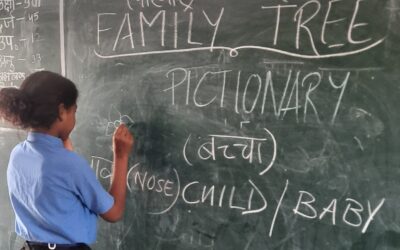Working and learning with children is about meeting serendipitous joys! While organizing library engagement sessions in several schools and community sites, we sometimes forget to have fun. However, the children never fail to bring us delight. At times, a single response from a child amazes me and lights up my mood for the day. Here, I want to share my experience with two special books, where the children’s responses not only made me happy but also made me think.
The school and community library program of Prayog follows a particular session calendar where each month is assigned a theme like Science, Nature, Childhood, Gender, Food, etc. Each week, we design a library session based on the theme and select a book from our well-curated collection. This time, focusing on the theme of Science and Nature, we decided to open two books: ‘Dharti ki Kahaani Antriksh‘ followed by ‘Zameen Humko Ghumati Hai‘. Both the books are amazingly written and illustrated. After a discussion among our team members, we concluded that Read Aloud would be the best-suited mode of engagement for these two books.
The Magical Tool of Read Aloud
The library practice of Read Aloud is great to invite young readers into the world of books and stories. Reading Aloud to children enables us to share the joy of a story in a fun and reflective way. It helps children experience the pleasure of reading. The practice of read aloud involves three parts:
- The pre-activity, where we set the context for the story through a game, song, or discussion
- The main story, where we read aloud the book
- In-between, we ask certain predictive questions to keep the children engaged and provoke their thinking, such as, “Aapko kya lagta hai, kahani mein aage kya hoga?”
- Finally, there is the post-activity where children recollect the story and engage in a related artwork or discussions or both
Children’s Responses: Delightful and Thought-Provoking
Our purpose was to introduce children to the Solar system, the family to which our Earth belongs. We chose to do this through the Read Aloud of the first book, ‘Dharti Ki Kahani Antriksh‘. I was particularly curious to observe children’s responses to the game of “Main Antriksh jaaunga/jaaungi, wahaan se ____ laaunga/laaungi“. (I’ll go to the space and bring back _____)
This pre-activity set the context of the story and encouraged children to think about what comprises space and what they would like to bring back to Earth. It is a sight to watch what children imagine when given a chance and space to do so, without any limitations. They wanted to bring moon, stars, water, Mars, books, and even aliens!


The focus was to make the informative book participatory and inclusive for each child present in the class. The questions during the story were designed to push them to think. One of the questions was “Why is there life only on Earth?” followed by “Do you think there’s life on any other planet?”.
Our approach as library educators is to listen to what children think, allowing them to express their own ideas and perspectives, even if they may not be scientifically or factually correct. We appreciate their attempts to answer rather than pointing out their mistakes in a derogatory way.
Children’s Literature Matters!
During a conversation with Keerti Jayaram, the Director of OELP (Organization for Early Literacy Promotion), she mentioned how conversations with children in classrooms are often mechanical and insensitive. “We don’t talk to them. We talk down upon them”, she said. It made me wonder how much space our education system gives children to express their thoughts and feelings.
There is a constant insistence on “knowing”, and if they don’t know, they may be shamed or labeled as illiterate or underperforming. Children are taught about the world before they even get to know themselves or what they can personally relate to. The current education system often overlooks a child’s sense of self.
Also Read: Visual Arts As A Way To Connect Children To The Library
This is why children’s literature matters! Engaging with such books is crucial for children. It provides a learning experience that feels safe and open, allowing them to feel a sense of ownership. Learning doesn’t have to be dry or earned through hardship.
Emotions and Learning
We thought it would be nice to continue the discussion with children from “Why is there life on Earth?” to “What is this life on Earth?” through our second book, ‘Zameen Humko Ghumati Hai‘, a poem written by Gulzar. It provokes thoughts about what the Earth does with the seeds we sow. And whether it performs magic or deceives us.



This poem led me to think about how learning can follow curiosity. Let’s first be curious and ask questions. Let’s imagine foolishly and boundlessly. Children would eventually learn the science of how plants grow and what the earth does with them. But wouldn’t it be great even if this poem generates curiosity and excitement in them?
My hands were happy while writing the session plan, specifically the purpose of the library session – ‘Inducing Curiosity…’. Not all purposes have to be as lofty as ‘Educating’. This made me connect the dots between emotions, awe, wonder, and learning. A comic strip by Zen Pencils sums up Rachel Carson’s words on wonder and excitement in an enriching way!




The Last Bit
Children thoroughly enjoyed the poem. In the post-activity, we asked them to draw how they imagined their Earth. The artwork that emerged was mesmerizing. At the end of the session, when we asked which part of the session they enjoyed the most, they answered in chorus, “Sab se zyada mazaa chitra banane mein aaya!“ (we enjoyed drawing the most) while joyfully showing us their hands filled with colors. My heart was full!








0 Comments